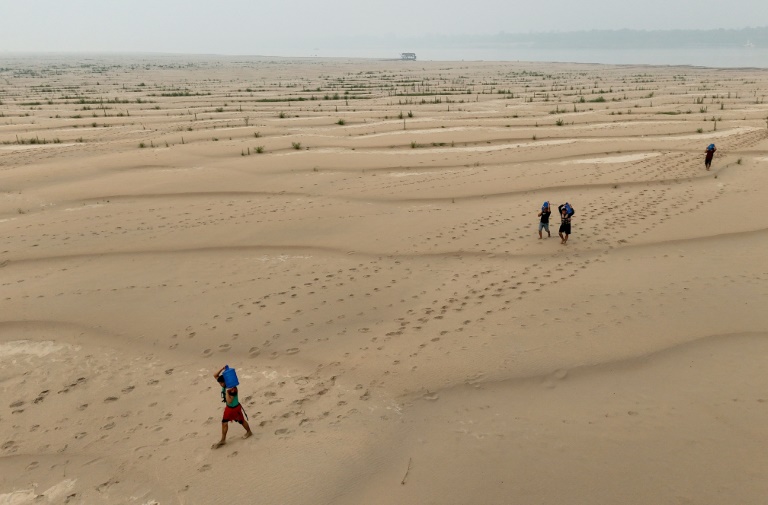Only the youngest and strongest villagers now dare to cross a vast, scorching sand plain where the waters of the mighty Madeira River in the Brazilian Amazon normally flow.
Residents of the village of Paraizinho, or “Little Paradise,” usually cross the river by canoe to reach the larger town of Humaita, which is essential for buying food and water, getting health care, and sending their children to school.
In drier periods this usually involves a short walk along a beach that becomes visible as the water level drops.
But as Brazil grapples with its worst drought in 70 years, water levels continue to drop, leaving a nearly kilometer-long strip of sand baking at temperatures of around 40 degrees Celsius.
“Every year it is worse. Last year more than half (of the river) dried up. This year it has dried up almost to the other side,” Reis Santos Vieira, a 69-year-old farmer, told AFP.
“And it is only expected to get worse,” he added.
The Madeira River, a major tributary of the Amazon that runs 3,300 km (2,050 miles) through Brazil and Bolivia, reached its lowest level this week since measurements began in 1967, according to Brazil’s Geological Survey (SGB).
– ‘A very difficult time’ –
Experts are linking Brazil’s historic drought to climate change. The arid conditions have fueled wildfires in the Amazon and elsewhere in the country, leaving major cities shrouded in smoke pollution.
For much of the day, the dry riverbed turns into a hell beneath your feet.
The approximately one hundred residents of Paraizinho “go on foot to that beach to transport the food and water that we need here. It is a very difficult time,” complained Sandra Gomes Vieira.
Last year, when there was also drought, one of her daughters burned her foot while crossing the riverbed and has refused to go to school since the sand appeared this year.
“My sister is undergoing cancer treatment and can’t go to the city. The health workers go to her house. I’m not very healthy either, but I still go,” Gomes said.
Five community volunteers recently carried containers of drinking water barefoot from Humaita to Paraizinho. Previously, these containers could easily be transported by canoe up the river.
“Here we only have the help of these people. Only them and God,” said Francisca de Chaga da Silva, one of the water recipients.
Community leader Joao Ferreira explained that the water will go to “the most vulnerable families, who have patients with high blood pressure and diabetes.”
Due to a water shortage, residents treat river water with chlorine to wash themselves, do dishes or wash clothes.
– ‘More smoke’ –
The ongoing drought has also affected economic activities in Paraizinho, especially fishing and the sale of agricultural products.
“The beach has grown a lot. Before, it was only two or three months of drought, “now we’re going for four, five months,” Ferreira said.
Communities along the banks of the Madeira River, a major trade route for soybeans, fish and fuel, are struggling. Some areas that also rely on Humaita are even worse off than Paraizinho, residents of the village say, because they are even further away.
Elsewhere in the Amazon region, fierce fires are also raging, sending a cloud of smoke into the village and surrounding area.
Authorities blame the fires in the country largely on human activity, often resulting from clearing land for agricultural purposes.
The weather “is warmer this year. There is also more smoke,” Sandra Gomes said.
One of her daughters “is experiencing chest pains from the smoke. She didn’t have this problem before.”
President Luiz Inacio Lula da Silva is expected to announce measures to address the effects of the drought in the Amazon region during a visit to the city of Manaus on Tuesday.
jss/app/fb/mlr/jgc







